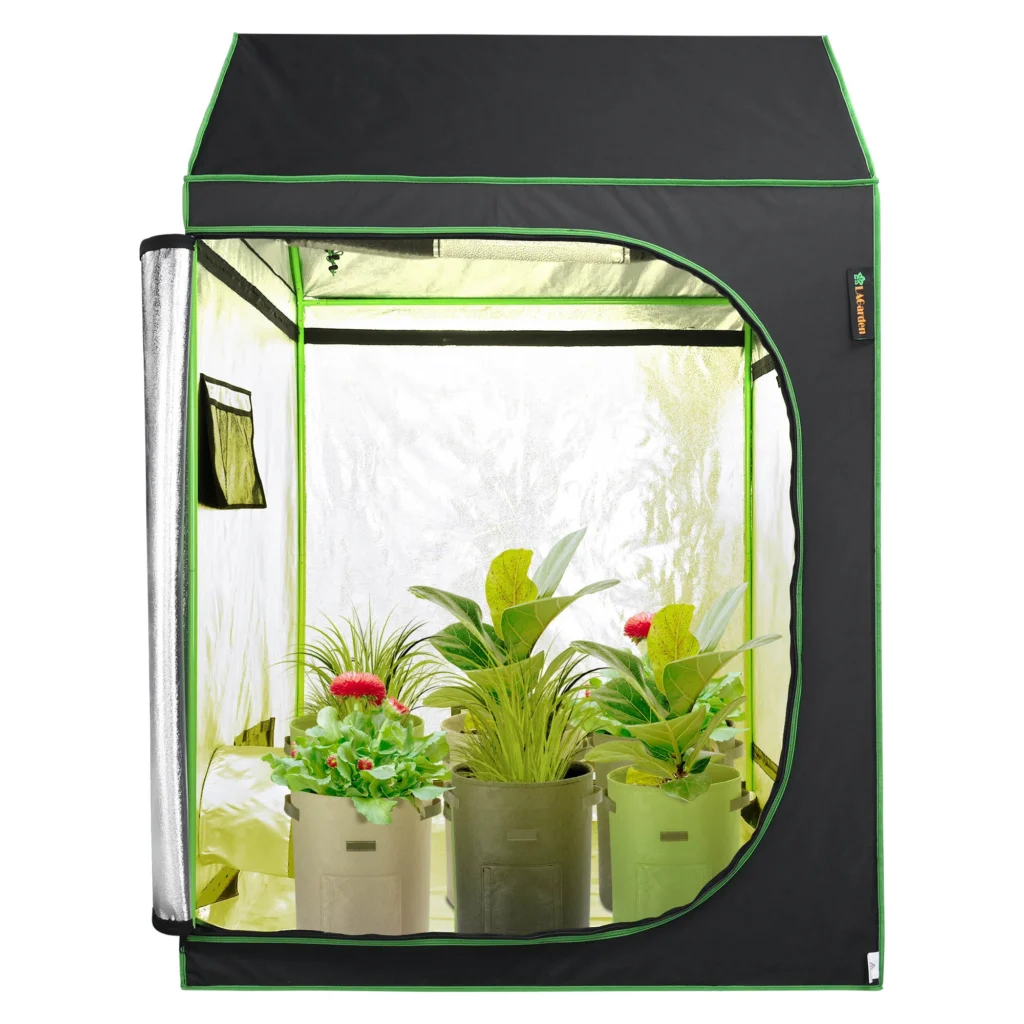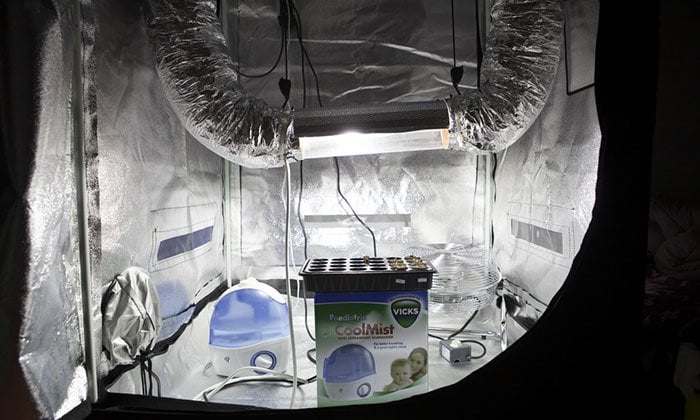A grow tent is not an absolute requirement for indoor gardening, but it offers numerous advantages. These tents enable the creation of a controlled environment, allowing precise management of crucial factors like temperature, humidity, light, and airflow necessary for optimal plant growth. Equipped with reflective interiors, they efficiently bounce light onto plants, maximizing artificial lighting and minimizing waste. Additionally, grow tents aid in odor control, especially beneficial for plants with strong scents, and act as a barrier against pests and contaminants, reducing the risk of infestations and diseases.
They also optimize space, coming in various sizes suitable for different living environments, and provide privacy and security for sensitive or legally restricted plants. While not mandatory, using a grow tent significantly enhances indoor gardening success by offering a controlled, protected, and tailored environment for plant cultivation.
What are tent features and benefits for indoor gardening?

Grow tents are enclosed, portable, and customizable spaces designed for indoor gardening. They provide a controlled environment for cultivating plants indoors. Here are some features and benefits of using grow tents for indoor gardening:
Features
Reflective Interior: Grow tents typically have highly reflective interiors (usually made of Mylar or similar materials) to maximize light distribution and intensity within the space. This helps in optimizing plant growth by ensuring light reaches all parts of the plants.
Lightproof Design: The tents are designed to prevent light from escaping or entering at unintended times. This feature helps in controlling the photoperiod (light/dark cycle) for the plants, mimicking natural daylight hours.
Ventilation Ports and Ducts: Grow tents come with ports and ducts for ventilation and air circulation. These allow for the installation of fans, filters, and other equipment to maintain optimal airflow, temperature, and humidity levels.
Sturdy Frame: Most grow tents have a durable frame made of metal poles or rods that provide structural support to the tent. This helps in hanging grow lights, fans, and other accessories without compromising the tent’s stability.
Zippered Doors and Windows: They come with zippered doors and sometimes windows for easy access to the plants and for maintenance tasks like watering, pruning, and inspecting plant health.
Multiple Sizes and Configurations: Grow tents are available in various sizes and configurations to suit different space requirements and plant types, making them versatile for different indoor gardening setups.
Benefits
Controlled Environment: Grow tents allow precise control over environmental factors like light, temperature, humidity, and airflow, creating an optimal growth environment for plants.
Year-Round Cultivation: They enable year-round gardening irrespective of external weather conditions, making it possible to grow plants continuously.
Space Optimization: Grow tents help maximize available space by concentrating light and resources specifically on the plants being cultivated, making them particularly useful in small indoor spaces.
Pest and Contamination Control: The enclosed space of a grow tent helps in minimizing the risk of pests, insects, and external contaminants affecting the plants.
Privacy and Odor Control: For plants that emit strong odors, grow tents can help contain and manage the smell, ensuring privacy and minimizing odor dissemination.
Easy Setup and Portability: Grow tents are relatively easy to set up and dismantle, and their portability allows gardeners to relocate their indoor garden if needed.
In summary, grow tents offer a controlled, customizable, and efficient space for indoor gardening, allowing enthusiasts to create ideal growing conditions for various plants throughout the year.
How do grow tents optimize plant growth and control environments indoors?
Grow tents optimize plant growth and control environments indoors through several mechanisms that create an ideal setting for plants to thrive. Here’s how they achieve this:
Light Optimization
Reflective Interior: The interior of grow tents is often lined with reflective materials like Mylar to ensure maximum light reflection. This helps in distributing light evenly across the plants, minimizing shadows and ensuring all parts receive adequate light.
Light Control: Grow tents prevent light leakage, maintaining a controlled photoperiod (light/dark cycle). This control over light exposure helps mimic natural daylight hours, influencing plant growth stages such as flowering and vegetative growth.
Temperature and Humidity Control
Ventilation and Air Circulation: Grow tents have ports and ducts for ventilation systems. Proper airflow helps regulate temperature and humidity levels within the tent, preventing excessive heat buildup and maintaining an optimal environment for plant growth.
Climate Control Devices: Gardeners can install fans, exhaust systems, heaters, or air conditioners within the tent to fine-tune temperature and humidity levels as needed for different plant species.
Pest and Contamination Management
Enclosed Space: The sealed nature of grow tents helps in creating a barrier against pests and external contaminants, reducing the risk of infestations or infections that can harm plant health.
Screened Vents and Filters: These tents often have screens or filters in their ventilation systems to prevent insects, dust, or other contaminants from entering the growing space.
Space Optimization and Customization
Compact and Versatile Design: Grow tents come in various sizes and configurations, allowing gardeners to optimize available space and customize the setup according to the number and type of plants being cultivated.
Efficient Use of Resources: By concentrating light and environmental resources within the tent, growers can provide targeted care to their plants, maximizing growth potential.
Ease of Monitoring and Maintenance
Easy Access: Zippered doors and windows provide convenient access for monitoring plant health, conducting maintenance tasks, and adjusting environmental conditions without disturbing the overall growing environment.
Controlled Conditions: The controlled environment allows growers to closely monitor and adjust factors such as light intensity, nutrient levels, and humidity, enabling precise control over the plant’s growth parameters.
Overall, grow tents serve as controlled environments where growers can optimize various growth factors, providing the ideal conditions for plants to flourish indoors throughout different stages of their growth cycle.
What are indoor growing alternatives and challenges?

Without dedicated grow tents, there are alternative methods and spaces for indoor gardening. However, these alternatives may come with their own set of challenges.
Indoor Growing Alternatives
Some individuals use open rooms or spaces within their homes for indoor gardening. This could involve using shelves, tables, or designated areas near windows to accommodate plants. Similar to growing tents but in a cabinet or cupboard form, these enclosed spaces allow for controlled environments for plant growth.
Creating makeshift enclosures using materials like PVC pipes, plastic sheeting, or reflective materials to construct a custom indoor growing area. These pre-built, enclosed systems often come with integrated lighting, ventilation, and environmental controls, functioning similarly to grow tents but in a box-like structure.
Challenges without Dedicated Grow Tents
Open spaces or DIY setups might lack the controlled environment that dedicated grow tents offer. Maintaining consistent temperature, humidity, and light distribution can be challenging.
Without a designated enclosure, space might become an issue, especially in smaller living areas. It can be challenging to optimize available space for efficient plant growth.
In open spaces, ensuring uniform light distribution across all plants may be difficult without reflective materials or specific lighting setups. Open environments are more susceptible to pests, insects, and external contaminants. Without proper enclosure and ventilation, controlling these issues becomes challenging.
Certain plants may emit strong odors that could permeate the living space. Without a dedicated enclosed area, managing and containing these odors might be more challenging. Limited access or awkward positioning can make plant maintenance tasks like watering, pruning, and inspecting for pests more cumbersome.
FAQ’s
What is the point of a grow tent?
The primary purpose of a grow tent is to create a controlled environment for indoor plant cultivation. It provides a space where factors like light, temperature, humidity, and airflow can be regulated, optimizing conditions for plant growth.
Do you need CO2 for a grow tent?
CO2 supplementation in a grow tent can enhance plant growth, especially in environments where natural CO2 levels are limited. However, it’s not always necessary for smaller setups where adequate ventilation and airflow exist.
Do grow tents reduce smell?
Grow tents can help contain and manage strong odors emitted by plants, but they might not eliminate smells entirely. Using additional carbon filters and proper ventilation can significantly reduce odors.
Are grow tents noisy?
Grow tents themselves are not noisy. However, the equipment inside, such as fans, pumps, or air filters, may generate noise. Choosing quieter or sound-insulated equipment can mitigate this issue.
Does a grow tent give off heat?
Grow tents don’t produce heat themselves, but the equipment inside, like grow lights and other electrical devices, can generate heat. Proper ventilation and cooling systems are essential to manage temperature within the tent.
Do you need humidity in a grow tent?
Maintaining proper humidity levels is crucial for plant health. Depending on the plants being grown, controlling humidity within a suitable range is necessary to support growth and prevent issues like mold or dehydration.
Final Words
In conclusion, grow tents offer many advantages for indoor gardening by providing a controlled environment. They help regulate temperature, humidity, and light, promoting healthier plant growth. Grow tents also keep pests away and optimize space, making indoor gardening more manageable.
While alternatives exist, the tailored environment of a grow tent contributes significantly to successful indoor plant cultivation.

